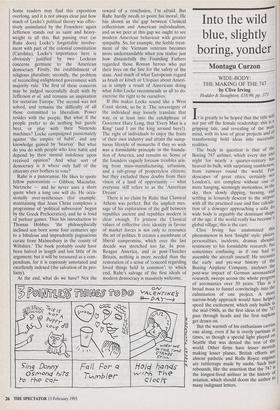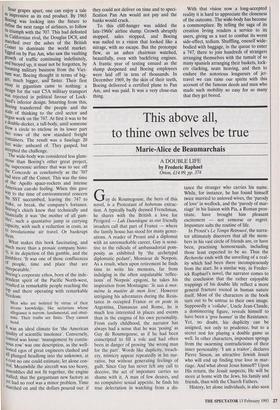Into the wild blue, slightly boring, yonder
Montagu Curzon
WIDE-BODY: THE MAKING OF THE 747 by Clive Irving
Hodder & Stoughton, f18.99, pp. 371
It is greatly to be hoped that the title will not put off the female readership: this is a gripping tale, and revealing of the male mind, with its love of great projects and of transforming bold ideas into successful realities.
The body in question is that of the Boeing 747 airliner, which every day and night for nearly a quarter-century has heaved its bulk, with surprising nimbleness, from runways round the world. Few skyscapes of great cities, certainly not London's, are complete without one or more hanging, seemingly motionless, in the sky, then slowly dipping, turning, and settling in leisurely descent to the airport with all the practised ease and fine calcula- tion of a dowager approaching a sofa. Its wide body is arguably the dominant shape of the age: if the world really has become a global village, this is the cart. Clive Irving has anatomised this phenomenon in best 'Insight' style: places, personalities, incidents, dramas abound, testimony to his formidable research, but sometimes confusing, as if one had to assemble the aircraft oneself. He recounts the early and pre-war history of the Boeing Airplane Company, analyses the post-war impact of German aeronautical research, sweeps across the whole progress of aeronautics over 50 years. This is a broad mass to funnel convincingly into the culmination of one project. A more, narrow-body approach would have helped speed the excitement, which only builds ih the mid-1960s, as the first ideas of the 747 pass through heads and the first napkins get drawn on. But the warmth of his enthusiasm carries one along, even if he is overly partisan at times, as though a special light played on Seattle that was denied the rest of the world. Other firms have lesser mortals making lesser planes, British efforts are almost pathetic and Rolls Royce engines are rattletraps made by snobs. Such bias rebounds, like the assertion that the 747 is the longest-lived airliner in the history of aviation, which should doom the author to many indignant letters. Sour grapes apart, one can enjoy a tale as Impressive as its end product. By 1965 Boeing was looking into the future to define the next range of airliners, to follow its triumph with the 707. This had defeated Its Californian rival, the Douglas DC8, and marched over the ashes of the British Comet to dominate the world market. Egged on by Pan Am, who saw the vaulting growth of traffic continuing indefinitely, and buoyed up, it must not be forgotten, by booming military business from the Viet- nam war, Boeing thought in terms of big- ger, much bigger, and`faster. Their first essay in gigantism came to nothing: a design for the vast C5A military transport was rejected in political favour of Lock- heed's inferior design. Smarting from this, Boeing transferred the people and the scale of thinking to the civil sector and k_ 'nun work on the 747. At first it was to be a double-decker, a tall-body, until someone drew a circle to enclose in its lower part two rows of the new standard freight containers. The result was a fuselage 20 feet wide: unheard of. They gasped, but accepted the challenge. The wide-body was considered less glam- orous than Boeing's other great project, the supersonic airliner that was to see off had Concorde as conclusively as the 707 Had seen off the Comet. This was the time of the Apollo space-rockets and intense American can-do feeling. When this gave hey to the time of environmental concern SST succumbed, leaving the 747 to Make, or break, the company's fortunes. Boeing's chiefs knew that technically and financially it was 'the mother of all gam- bles', such a quantative jump in carrying capacity, with such a reduction in costs, as to revolutionise air travel. Or bankrupt them.
What makes this book fascinating, and Much more than a prosaic company histo- ry, is its depiction of this gamble, and the gamblers: 'It was one of those confluences of people, time and place that are unrepeatable.' Boeing's corporate ethos, born of the inde- pendent spirit of the Pacific North-west, resulted in remarkable people reaching the ,MP and there operating with remarkable freedom:
Men who are isolated by virtue of their arcane knowledge, like sectarians whose allegiance is narrow, fundamental, and obsti- nate. Their truths are finite. They cannot bend.
It was an ideal climate for 'the American quality of scientific insolence'. Conversely, control was loose: 'management by contin- uous row' was one description, as the well- boned egos of great engineers clashed and all plunged headlong into the unknown, at a cost no one could estimate, let alone con- trol. Meanwhile the aircraft was too heavy, assemblies did not fit together, the engine stalled; that the gargantuan new factory as Yet had no roof was a minor problem. Time Marched on and the dollars poured out: if
they could not deliver on time and to speci- fication Pan Am would not pay and the banks would crack.
To this cliff-hanger was added the late-1960s' airline slump. Growth abruptly stopped, sales stopped, and Boeing was nailed to a vision that looked like a mirage, with no escape. But the prototype flew, as an ashen chairman watched, beautifully, even with backfiring engines. A frantic year of testing ensued as the slump deepened and Boeing employees were laid off in tens of thousands. In December 1969, by the skin of their teeth, Boeing delivered a certified plane to Pan Am, and was paid. It was a very close-run thing. With that vision now a long-accepted reality it is hard to appreciate the closeness of the outcome. The wide-body has become a commonplace. By telling the saga of its creation Irving renders a service to its users, giving us a tool to combat its worst side-effect, tedium. Shuffling, oneself wide- bodied with baggage, in the queue to enter a 747, there to join hundreds of strangers arranging themselves with the tumult of so many spaniels arranging their baskets, lock- ers clacking, seats heaving, and then to endure the notorious longueurs of jet- travel we can raise our spirits with this account of the famous deeds and men who made such mobility so easy for so many that they get bored.



















































 Previous page
Previous page